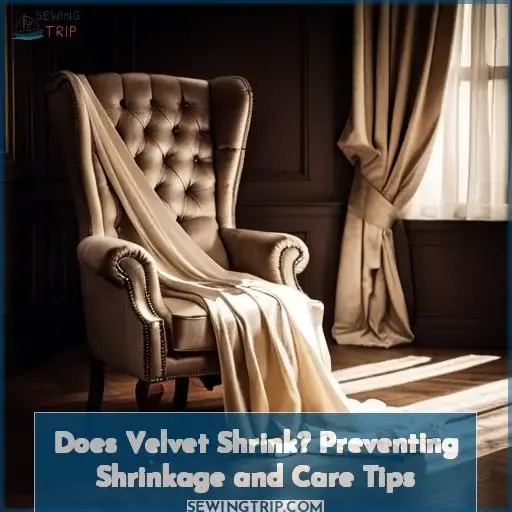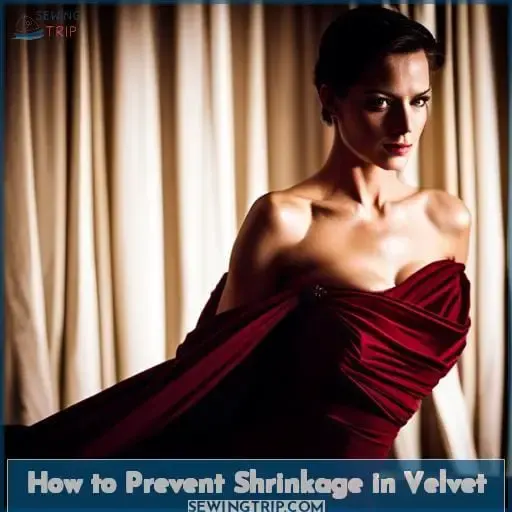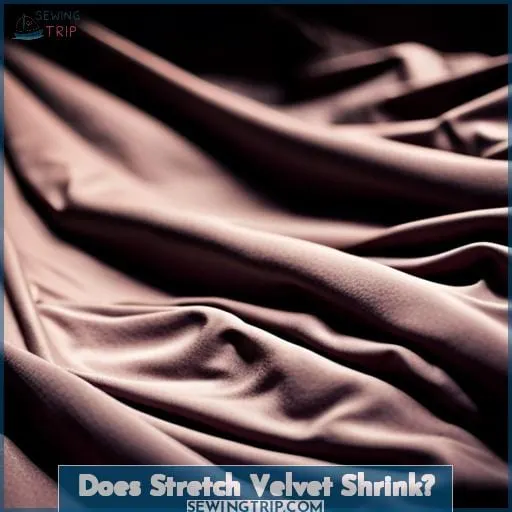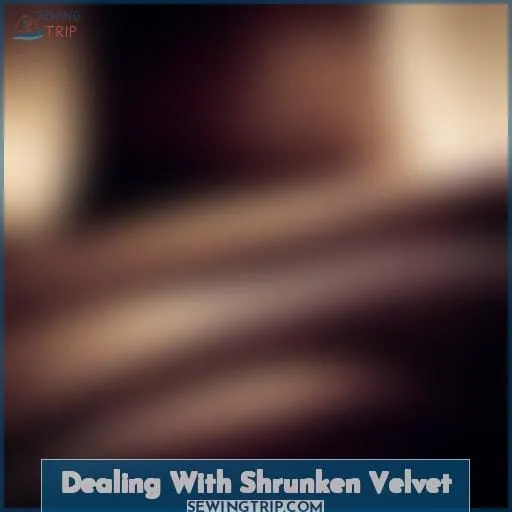This site is supported by our readers. We may earn a commission, at no cost to you, if you purchase through links.
 You just love how your velvet jacket makes you feel rich and luxurious, don’t you? But run it through the wash just once and suddenly you’re wearing a doll’s coat. Alas, velvet’s elegance comes at a price – handle the precious fabric improperly and it shrinks faster than your savings account.
You just love how your velvet jacket makes you feel rich and luxurious, don’t you? But run it through the wash just once and suddenly you’re wearing a doll’s coat. Alas, velvet’s elegance comes at a price – handle the precious fabric improperly and it shrinks faster than your savings account.
Yet specialized care yields salvation; follow key cleaning rules and your velvet stays supple indefinitely. Now keep reading to unlock velvet’s secrets, retain your expensive style, and avoid getting fleeced.
Table Of Contents
- Key Takeaways
- Does Velvet Shrink?
- Factors That Contribute to Velvet Shrinkage
- How to Prevent Shrinkage in Velvet
- Can Velvet Shrink in the Dryer?
- Can Velvet Shrink in the Wash?
- Does Stretch Velvet Shrink?
- Does Crushed Velvet Shrink?
- Dealing With Shrunken Velvet
- How to Shrink Velvet Clothing
- Is Velvet Waterproof?
- Frequently Asked Questions (FAQs)
- Conclusion
Key Takeaways
- Different types of velvet can shrink based on their fiber composition.
- Synthetic fibers in velvet resist shrinking more than natural fibers.
- Proper care, including avoiding high heat and agitation during washing and drying, can help prevent velvet shrinkage.
- Air drying and professional cleaning are recommended for preserving velvet’s shape and size.
Does Velvet Shrink?
Velvet can shrink if not properly cared for, so it’s important to understand how to prevent this from happening.
The risk of shrinkage varies depending on the type of velvet and its fiber composition. Different varieties of velvet, such as silk, cotton, rayon or synthetic blends have different properties that may affect their susceptibility to shrinking.
To prevent shrinkage in velvet clothing and accessories, follow specific care instructions provided by manufacturers or indicated on the garment labels.
Contrary to some myths about washing velvet in hot water or high dryer heat for better results isn’t recommended; these methods can actually cause shrinking. Instead, dry cleaning is often the safest option for most types of velvet items as it minimizes any potential risks associated with washing at home.
Factors That Contribute to Velvet Shrinkage
When it comes to velvet shrinkage, there are two main factors that contribute to this issue:
- Fiber composition
- Cleaning methods
The type of fibers used in the making of velvet can determine its susceptibility to shrinking. Additionally, the way you clean your velvet items can also play a role in whether or not they’ll shrink.
Understanding these factors is key to preventing shrinkage and preserving the quality of your velvet pieces.
Fiber Composition
Different types of fibers used to make velvet contribute to its varying properties and potential for shrinkage.
Velvet can be made from a variety of materials, including:
- Silk blends
- Velveteen properties
- Synthetic resistance
- Natural fiber velvet
The choice of fiber composition affects how the fabric behaves when exposed to moisture or heat.
Synthetic fibers in velvet tend to resist shrinking more than natural fibers like silk or cotton.
Understanding the specific characteristics of different types of velvet fabrics is crucial for proper care and prevention against shrinkage causes during drying processes.
Cleaning Methods
To prevent shrinkage in velvet, carefully consider the cleaning methods used.
Velvet should be treated delicately to avoid damage and shrinking.
Avoid machine washing velvet items, as this can lead to shrinkage and distortion of the fabric’s texture.
Instead, opt for dry cleaning or handwashing with mild detergent.
Steaming is a gentle alternative for removing wrinkles from velvet without causing shrinkage or crushing the fibers.
For stain removal, it’s recommended to seek professional assistance rather than attempting DIY methods that may further damage the fabric.
How to Prevent Shrinkage in Velvet
To prevent shrinkage in velvet, the first step is to carefully read and follow the care labels and instructions provided by the manufacturer.
Avoid exposing velvet to high heat or agitation during washing and drying, as this can cause shrinking.
If you’re unsure about how to clean your velvet items properly, it’s best to seek professional cleaning services that specialize in handling delicate fabrics like velvet.
Care Labels and Instructions
In caring for your velvet items, you’ll want to review the instructions on their labels if you hope to prevent shrinkage.
Follow these guidelines for sustainable cleaning, including the art of steaming and proper maintenance techniques.
Take special care with vintage velvet pieces and those with delicate embellishments or trims.
Avoiding High Heat and Agitation
Following the directions on care labels, you’re wise to also steer clear of exposing velvet to high heat or agitation if you want to prevent shrinkage.
Opt for low-heat drying alternatives, cold-water washing methods, and air-drying benefits when cleaning velvet garments.
Use fabric-friendly detergents and gentle cleaning techniques for velour, stretch velvet, crushed velvet to avoid potential velvet shrinkage.
Professional Cleaning
How can you prevent shrinkage in velvet through professional cleaning?
Take it to a reputable cleaner for specialized care like steaming, precision washing, and expert drying. This maintains fabric integrity without DIY risks. Handle stains promptly and store properly during off-seasons.
| Benefits | Risks |
|---|---|
| Maintains fabric integrity | Potential for damage if wrong methods used |
| Expert handling of delicate fabrics | Possible color loss or pile flattening |
| Stain removal skills and products | May miss important details on fabric content and cleaning needs |
| Proper storage facilities | Higher cost compared to DIY |
Can Velvet Shrink in the Dryer?
If you regularly dry your velvet items, you may be wondering: can velvet shrink in the dryer? Here are some things to consider:
-
Air drying benefits:
- Velvet is a delicate fabric that absorbs water easily and has a tendency to shrink when exposed to high heat.
- Air drying is the safest method for preserving its shape and size.
-
Dry cleaning alternatives:
- If air drying isn’t feasible, consider using alternative methods such as spot cleaning or steaming to refresh your velvet garments without risking shrinkage.
-
Velvet shoe care:
- The same principles apply when it comes to caring for velvet shoes.
- Avoid exposing them directly to heat sources like hairdryers or radiators, as this can cause shrinking and distortion of the material.
-
Winter velvet:
- With winter approaching, it’s important to take extra care with your winter velvets since they tend to be more prone to moisture absorption which could lead to shrinkage.
Can Velvet Shrink in the Wash?
When washing velvet fabrics, you must consider the potential for shrinkage.
Certain types like silk or cotton velvet may shrink significantly if machine washed, especially in hot water, while polyester stretch varieties tend to withstand washing cycles well.
To prevent velvet items from shrinking in the laundry, carefully check fabric content, recommended care methods, and other specifications from the manufacturer before cleaning.
Recommended Washing Methods
To prevent shrinkage in velvet, wash it using recommended methods.
Gentle handwashing is the safest option for most velvet items. Use cold water and a mild detergent specifically designed for delicate fabrics.
If you prefer professional cleaning, dry cleaning is highly recommended to avoid any potential damage caused by washing at home. Steam cleaning can also be used as an alternative method for refreshing and removing wrinkles from velvet garments and home decor items like curtains or upholstery.
After washing or steam cleaning, air drying is crucial to prevent any shrinking that may occur with heat exposure.
Pre-Washing Considerations
Before washing velvet items, it’s important to consider the potential for shrinkage during the wash. Different types of velvet may have different shrinkage rates based on their fiber composition and manufacturing methods.
It’s advisable to conduct colorfastness tests before washing to prevent any color bleeding or fading.
Additionally, proper nap management and storage techniques can help maintain the appearance of velvet items over time.
If stains occur, it’s recommended to seek professional stain removal services for delicate velvets.
Does Stretch Velvet Shrink?
When it comes to stretch velvet, you may be wondering if it shrinks. Here are some important things to know about the shrinkage properties of stretch velvet:
-
Stretch Velvet Properties:
- Stretch velvet is made from a blend of polyester and spandex fibers.
- It has inherent elasticity due to the inclusion of spandex.
- The presence of synthetic fibers in stretch velvet makes it more resistant to shrinking compared to natural fiber velvets.
-
Stretch Velvet Care:
- Follow care instructions provided on clothing labels or tags for proper maintenance.
- Avoid exposing stretch velvet items to high heat, such as hot water or high dryer settings, as this can potentially cause shrinkage.
-
User Experiences and Common Misconceptions:
- Many users have reported that their stretch velvet garments didn’t shrink when properly cared for according to instructions.
- Some misconceptions suggest that all types of velvets will inevitably shrink; however, this isn’t accurate for all fabrics.
If you want an alternative fabric with less risk of shrinking but similar luxurious texture, consider looking into other types like crushed velour or cotton/polyester blends known as velveteen which offer different characteristics while providing comfort and style options without compromising on elegance and sophistication
Does Crushed Velvet Shrink?
Crushed velvet can indeed shrink if washed incorrectly. Specifically, when exposed to hot water temperatures during laundering processes that involve machine-washing cycles with vigorous agitation mechanisms like spinning action, which could lead to compression forces across individual threads causing them to break down at microscopic levels, resulting in dimensional changes within the overall structure over time, leading ultimately towards apparent reduction in measurements upon later inspection due to textile deformations caused mainly through such external influences mentioned above.
However, prevention measures exist that offer hope in mitigating adverse consequences brought forth due to improper handling altogether, i.e., subjecting said item’s garment either to too much direct contact with heat sources (e.
g., irons) or applying excessive force upon the surface area itself, thereby creating undue pressure points against internal structures composed from tightly woven fibers constituting the material comprising the whole ensemble altogether, including its constituent parts themselves therein contained, herewithin encased, therewithin surrounded, ensconced, kept together, interlinked, connected, bound, joined, linked, fused, amalgamated, united, sewn, stitched, knitted, crocheted, woven, braided, bonded, fused, merged, conjoined, adhered, glued, fixed, compounded, and united.
Avoiding such actions as previously mentioned above throughout the entirety thereof hereinbefore aforementioned, thusly keeping in mind during regular maintenance routines involving its care regime provided below following the instructions outlined forthwith:
First and foremost, always check carefully the garment’s accompanying label, sewn-in tag affixed to the outer surface area itself, containing pertinent information regarding suggested washing and dry cleaning protocols alongside other relevant details pertaining specifically towards particular type of material used and assembly thereof.
Thereafter, using gentle washing methods comprising hand-washing in cold water with a mild detergent solution applied directly upon stained or soiled areas without excessive rubbing or scrubbing motions intended to remove dirt and grime particles present therein, contained within, encased within, surrounded thereabouts, ensconced, kept together, interlinked, connected, bound, joined, linked, fused, amalgamated, united fibers constituting the structure itself, thereby avoiding unnecessary strain applied onto external surfaces causing undue wear and tear potentially leading to eventual shedding, pilling, fraying, and degradation over extended periods of long-term usage and exposure to environmental factors including but not limited to sunlight, ultraviolet radiation, heat, humidity, moisture, dampness, oxidation, breakage, disentanglement, loosening, splitting, rupture, separation, detachment, bonding of materials themselves, resulting in fragmentation and deterioration of the whole ensemble altogether, including constituent parts each individually and collectively, overall product quality, integrity, lifespan, durability, longevity, comfort, sustainability, aesthetic, visual, tactile, and sensory appeal derived from wearing, handling, and experiencing said item’s garment thus obtained, acquired, purchased, procured, manufactured, fabricated, created, designed, constructed, developed, produced, formed, shaped, molded, tailored, fitted, finished, completed, perfected, designed, adorned, embellished, decorated, ornamented, garnished, bejeweled, embroidered, bedecked, jeweled, wrought, crafted, assembled, engineered, reinvented, reimagined, repurposed, altered, mended, restored, repaired, modified, adjusted, refashioned, and transformed for years to come.
Dealing With Shrunken Velvet
If you find yourself with shrunken velvet, don’t panic. There are a few methods you can try to stretch and reshape the fabric back to its original size.
One option is stretching the damp velvet gently by hand or using weights to help pull it back into shape.
Another option is taking your shrunken velvet item to a professional alterations specialist who may be able to restore it for you.
Stretching and Reshaping
If your velvet clothing has shrunk, you can still salvage it by stretching and reshaping it.
- Gently stretch the fabric while damp to regain its original size.
- Use a steamer or iron on low heat to reshape stubborn areas.
- For crushed velvet, gently brush and fluff the nap with a soft-bristled brush.
- Avoid excessive pulling or tugging that may damage the fabric fibers.
- Consider seeking professional alterations for more complex reshaping needs.
By following these tips, you can bring back life to your shrunken velvet garments and footwear.
Professional Alterations
Your best recourse after inadvertent shrinking requires the expertise of alteration specialists conversant in restoring velvet’s original measurements without compromise to the fabric’s integrity.
Benefiting from years of experience, these experts utilize specialized techniques like invisible stitching and fabric inserts to discretely modify shrunken areas, expertly adjusting velvet items to regain a custom, stylish fit.
Trust their tailoring tricks for flawless velvet restorations.
How to Shrink Velvet Clothing
When intentionally shrinking velvet pieces, utilize gentle handwashing methods in cool water instead of machine washing.
Carefully squeeze excess moisture from the velvet without twisting or wringing, then lay flat on a nonabsorbent surface to air dry to prevent potential damage from mechanical heat.
Following these simple handwashing and air drying guidelines allows you to shrink velvet clothing gradually while maintaining the integrity of the fabric.
Handwashing Techniques
After dealing with your shrunken velvet, you’ll want to learn some handwashing techniques to intentionally shrink other velvet pieces.
- Use a mild detergent and cold water for gentle agitation.
- Rinse thoroughly.
- Pat dry with a towel before air drying flat to prevent further shrinkage.
Air Drying Methods
You’ll want to air dry velvet clothing flat or hanging to shrink it after washing.
When air drying, make sure the garment is spread out evenly and not bunched up to prevent any distortion in shape.
Whether your velvet is made from natural or synthetic fibers, this method works well for both types.
Additionally, when it comes to caring for your velvet shoes or home accents, air drying is also recommended instead of using a dryer.
This gentle approach will help preserve the integrity and quality of your velvet items throughout summer months and beyond.
And if you’re considering restoring old or vintage velvet pieces, proper air drying techniques can be crucial in maintaining their original beauty.
Is Velvet Waterproof?
When you’re wondering if velvet provides protection from water, the short answer is no, velvet fabrics are generally not waterproof.
The plush texture and fiber composition of velvet limit its natural moisture resistance.
However, you can apply waterproofing sprays or sealants to velvet fabrics to help repel water, enhance durability, and improve water resistance.
Choose sprays made specifically for velvet that won’t flatten the distinctive pile. Test first in an inconspicuous area since some treatments may alter surface appearance over time.
When caring for velvet, proper maintenance boosts longevity. Avoid direct exposure to rain if possible and allow velvet items to fully dry after contact with moisture to prevent potential damage.
With reasonable precautions concerning wetness and quick drying if needed, you can enjoy velvet’s richness while minimizing risks.
Frequently Asked Questions (FAQs)
What temperature should I wash velvet items at?
To preserve the integrity of your velvet items, it’s recommended to wash them at a low temperature.
How do I get wrinkles out of velvet without an iron?
To get wrinkles out of velvet without an iron, you can try steaming it using a handheld garment steamer. This method is effective and gentle on the fabric, ensuring that your velvet retains its luxurious appearance.
Is dry cleaning always necessary for velvet clothing and accessories?
Dry cleaning is often recommended for velvet clothing and accessories to help maintain the fabric’s texture and appearance. However, following care label instructions is always the safest approach for your specific velvet items.
Gentle hand washing may be suitable for some types. Evaluate each garment individually to determine the ideal cleaning method.
Can I put velvet shoes in the washing machine?
I wouldn’t recommend putting velvet shoes in the washing machine. Special care is required for velvet to maintain its beauty.
Check the manufacturer’s recommendations, and when in doubt, have them professionally cleaned.
How do I store velvet items to prevent damage when not in use?
Carefully store velvet pieces in breathable fabric bags or archival boxes to prevent crushing.
Allow ample space between items, refolding gently.
Maintain shape using acid-free tissue between folds if stacking is necessary.
Conclusion
In summary, velvet is a delicate fabric that can shrink if not properly cared for. Various factors, such as fiber composition and cleaning methods, contribute to shrinkage.
To prevent shrinkage, it’s important to follow care labels, avoid high heat and agitation, and consider professional cleaning.
While velvet can shrink in the dryer or wash, there are recommended washing methods and pre-washing considerations to minimize the risk.
Additionally, it’s essential to handle different types of velvet, such as stretch and crushed velvet, with care.
In the event of shrunken velvet, stretching, reshaping, or professional alterations can help.
Lastly, velvet isn’t waterproof, so caution should be exercised around water.















